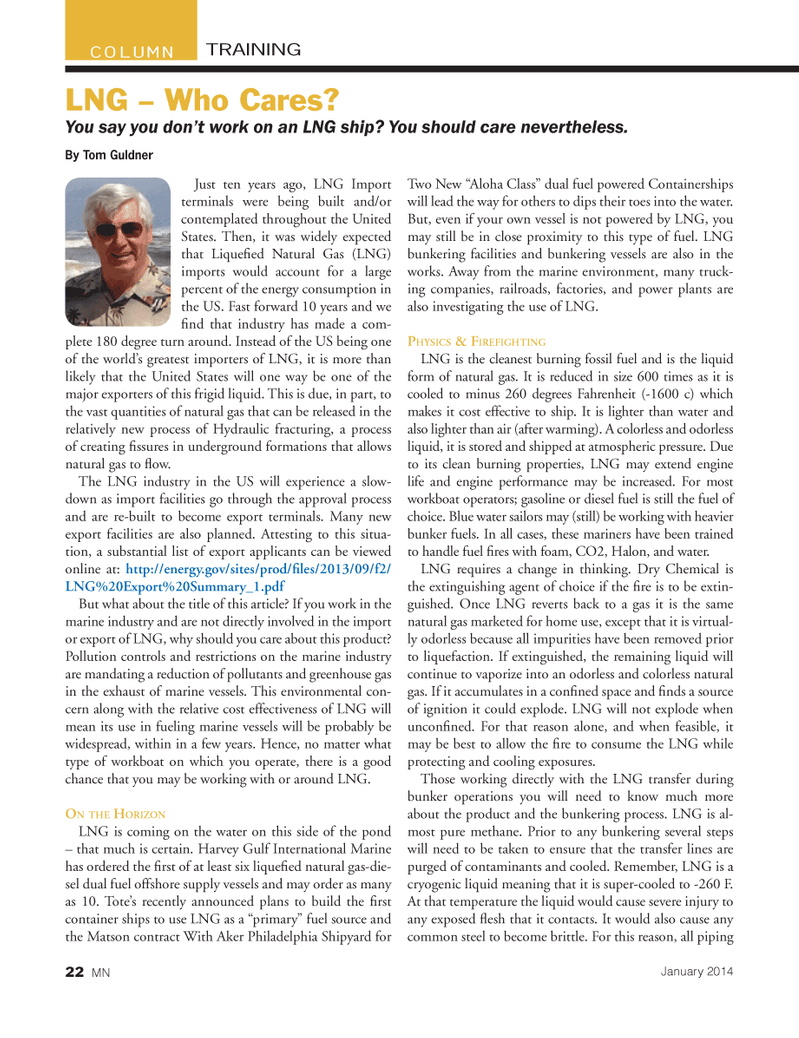
Page 22: of Marine News Magazine (January 2014)
Tug Boat Technology
Read this page in Pdf, Flash or Html5 edition of January 2014 Marine News Magazine
Just ten years ago, LNG Import terminals were being built and/or contemplated throughout the United
States. Then, it was widely expected that Liquefi ed Natural Gas (LNG) imports would account for a large percent of the energy consumption in the US. Fast forward 10 years and we fi nd that industry has made a com- plete 180 degree turn around. Instead of the US being one of the world’s greatest importers of LNG, it is more than likely that the United States will one way be one of the major exporters of this frigid liquid. This is due, in part, to the vast quantities of natural gas that can be released in the relatively new process of Hydraulic fracturing, a process of creating fi ssures in underground formations that allows natural gas to fl ow.
The LNG industry in the US will experience a slow- down as import facilities go through the approval process and are re-built to become export terminals. Many new export facilities are also planned. Attesting to this situa- tion, a substantial list of export applicants can be viewed online at: http://energy.gov/sites/prod/fi les/2013/09/f2/
LNG%20Export%20Summary_1.pdf
But what about the title of this article? If you work in the marine industry and are not directly involved in the import or export of LNG, why should you care about this product?
Pollution controls and restrictions on the marine industry are mandating a reduction of pollutants and greenhouse gas in the exhaust of marine vessels. This environmental con- cern along with the relative cost effectiveness of LNG will mean its use in fueling marine vessels will be probably be widespread, within in a few years. Hence, no matter what type of workboat on which you operate, there is a good chance that you may be working with or around LNG.
ON THE HORIZON
LNG is coming on the water on this side of the pond – that much is certain. Harvey Gulf International Marine has ordered the fi rst of at least six liquefi ed natural gas-die- sel dual fuel offshore supply vessels and may order as many as 10. Tote’s recently announced plans to build the fi rst container ships to use LNG as a “primary” fuel source and the Matson contract With Aker Philadelphia Shipyard for
Two New “Aloha Class” dual fuel powered Containerships will lead the way for others to dips their toes into the water.
But, even if your own vessel is not powered by LNG, you may still be in close proximity to this type of fuel. LNG bunkering facilities and bunkering vessels are also in the works. Away from the marine environment, many truck- ing companies, railroads, factories, and power plants are also investigating the use of LNG.
PHYSICS & FIREFIGHTING
LNG is the cleanest burning fossil fuel and is the liquid form of natural gas. It is reduced in size 600 times as it is cooled to minus 260 degrees Fahrenheit (-1600 c) which makes it cost effective to ship. It is lighter than water and also lighter than air (after warming). A colorless and odorless liquid, it is stored and shipped at atmospheric pressure. Due to its clean burning properties, LNG may extend engine life and engine performance may be increased. For most workboat operators; gasoline or diesel fuel is still the fuel of choice. Blue water sailors may (still) be working with heavier bunker fuels. In all cases, these mariners have been trained to handle fuel fi res with foam, CO2, Halon, and water.
LNG requires a change in thinking. Dry Chemical is the extinguishing agent of choice if the fi re is to be extin- guished. Once LNG reverts back to a gas it is the same natural gas marketed for home use, except that it is virtual- ly odorless because all impurities have been removed prior to liquefaction. If extinguished, the remaining liquid will continue to vaporize into an odorless and colorless natural gas. If it accumulates in a confi ned space and fi nds a source of ignition it could explode. LNG will not explode when unconfi ned. For that reason alone, and when feasible, it may be best to allow the fi re to consume the LNG while protecting and cooling exposures.
Those working directly with the LNG transfer during bunker operations you will need to know much more about the product and the bunkering process. LNG is al- most pure methane. Prior to any bunkering several steps will need to be taken to ensure that the transfer lines are purged of contaminants and cooled. Remember, LNG is a cryogenic liquid meaning that it is super-cooled to -260 F.
At that temperature the liquid would cause severe injury to any exposed fl esh that it contacts. It would also cause any common steel to become brittle. For this reason, all piping
LNG – Who Cares?
You say you don’t work on an LNG ship? You should care nevertheless.
By Tom Guldner
TRAINING
COLUMN 22 MN
January 2014
MN JAN14 Layout 18-31.indd 22 12/20/2013 10:05:49 AM

 21
21

 23
23
